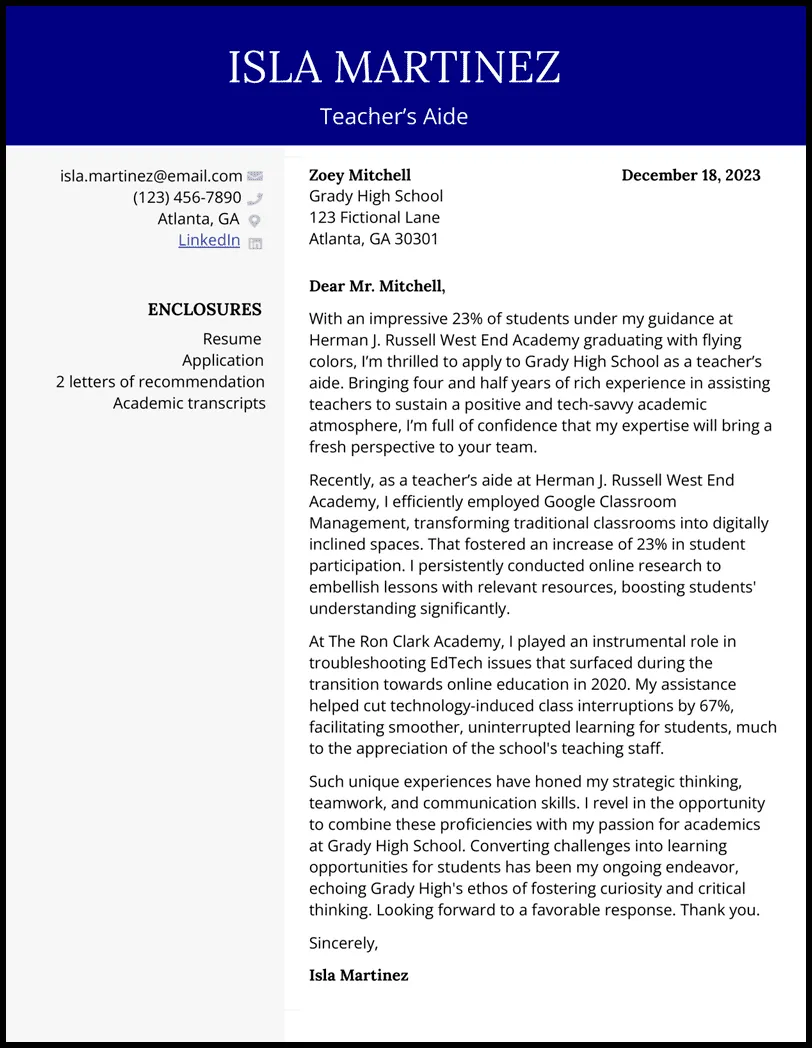Understanding the Importance of a Cover Letter
A well-crafted cover letter is your first introduction to a potential employer and an essential component of any job application, especially for a role as a paraeducator. It serves as an opportunity to go beyond the confines of your resume and provide a more detailed glimpse into your personality, skills, and experience. In the competitive field of education, a strong cover letter can be the difference between landing an interview and being overlooked. It’s a chance to demonstrate your understanding of the specific requirements of the role and to express your genuine interest in the school or district you are applying to. A cover letter is not just a formality; it’s a powerful tool to make a positive first impression.
Why a Cover Letter Matters for Paraeducators
For paraeducators, a cover letter allows you to highlight your passion for supporting students and your ability to contribute to a positive learning environment. Many paraeducator roles require a diverse set of skills, including classroom management, communication, and the ability to work collaboratively with teachers and parents. Your cover letter is where you can explicitly demonstrate these skills, providing specific examples of how you’ve successfully supported students and contributed to their academic and social-emotional growth. It’s also an excellent opportunity to show your understanding of the school’s mission and values and how your personal and professional goals align with their educational philosophy. Emphasize your commitment to fostering a supportive and inclusive classroom.
Highlighting Relevant Skills and Experience
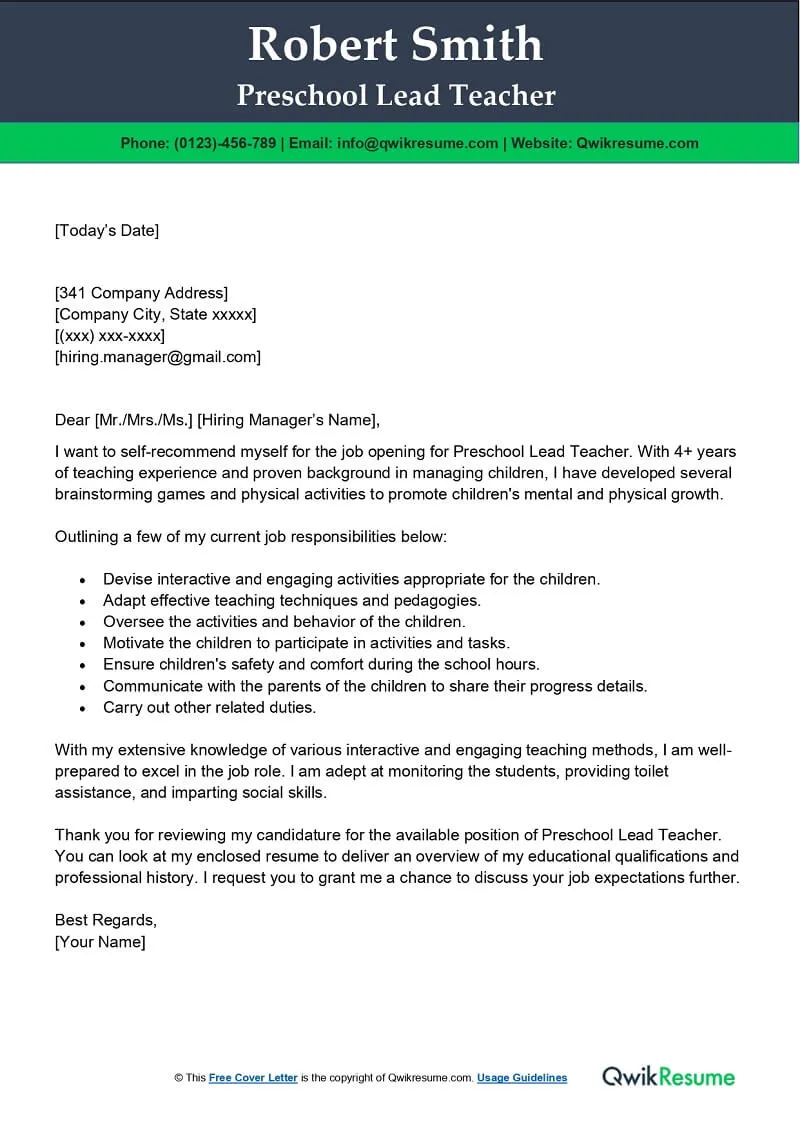
The cover letter provides space to elaborate on the skills and experiences briefly mentioned in your resume. It allows you to connect your qualifications directly to the needs of the position. Focus on showcasing experiences that demonstrate your ability to succeed as a paraeducator. These may include experience in assisting students with their school work, classroom management, and any specialized skills you may possess such as experience working with children with special needs, or knowledge of specific educational technologies. The goal is to paint a clear picture of what you can bring to the role and the positive impact you can have on the students and the school community.
Identifying Key Skills for Paraeducators
Paraeducator roles require a variety of skills. Communication is essential; the ability to effectively communicate with students, teachers, and parents is paramount. Patience, empathy, and the ability to adapt to different learning styles are also crucial. Highlight your experience with classroom management, and your ability to maintain a productive and respectful learning environment. Mention your proficiency in using educational software, assistive technology, or any other relevant tools. Strong organizational skills are also valuable; demonstrate your ability to manage time, and stay organized in a busy classroom setting. Your cover letter should highlight the skills and experiences that align directly with the job description.
Showcasing Experience in Education
Describe your experience working in educational settings. Include the types of schools or programs you have worked in, the grade levels you supported, and the specific responsibilities you held. Provide concrete examples of how you have assisted students in their learning journey. Detail any specific strategies or methods you used to support students with different learning needs, such as providing one-on-one tutoring, or small group instruction. Highlight any training or certifications you have received in the field of education. The goal is to paint a clear and compelling picture of your capabilities and suitability for the paraeducator position. Emphasize your dedication to helping students succeed.
Tailoring Your Cover Letter to the Job Description
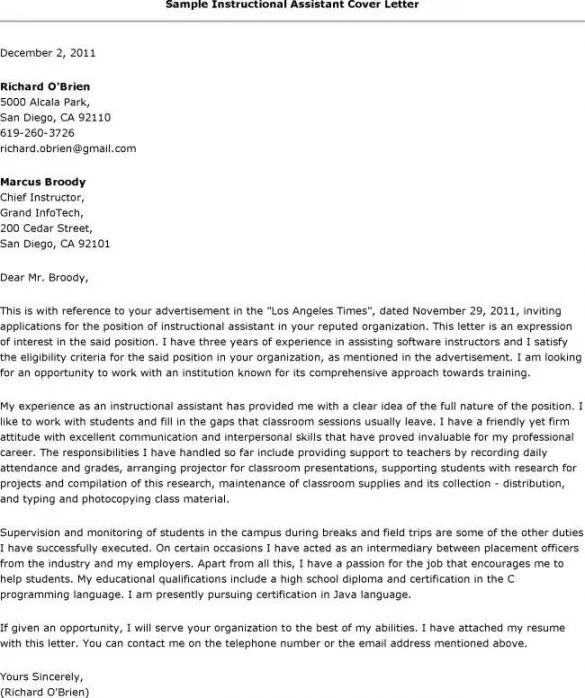
Generic cover letters do not impress hiring managers. To stand out, tailor your letter to each job application. Customization demonstrates your interest and shows that you have carefully read the job description. By personalizing your letter, you will be able to address the specific requirements and expectations outlined in the job posting. Identify the most important skills, qualifications, and experience the employer is seeking. Then, align your experiences and skills with these requirements. This process makes your application relevant and increases the chances of getting noticed. This shows the employer that you are a good fit for the position.
Analyzing the Job Posting for Keywords
Carefully read the job description and identify the keywords. These are the terms and phrases that the employer uses to describe the role and the ideal candidate. Note words related to specific skills, responsibilities, and qualifications. Make a list of these keywords. Then, strategically incorporate these keywords into your cover letter. For example, if the job description emphasizes the need for experience with a specific teaching method, ensure that you mention your experience with that method. This shows that you are a good match for the role. It helps ensure your cover letter will be noticed by hiring managers. This is particularly important for applications processed through an applicant tracking system (ATS).
Customizing Your Letter for Each Application
Once you have identified the keywords, use them naturally throughout your cover letter. Avoid keyword stuffing; instead, integrate these terms into the narrative of your letter. Highlight the aspects of your experience and skills that directly relate to the job description. Use the job description as a guide to what the employer is looking for and directly address these points. Mention the specific school or district and express your enthusiasm for the opportunity to contribute to their educational environment. Tailoring your cover letter will demonstrate to the employer that you are genuinely interested in the role and have taken the time to understand their needs.
Formatting and Structure for a Professional Look
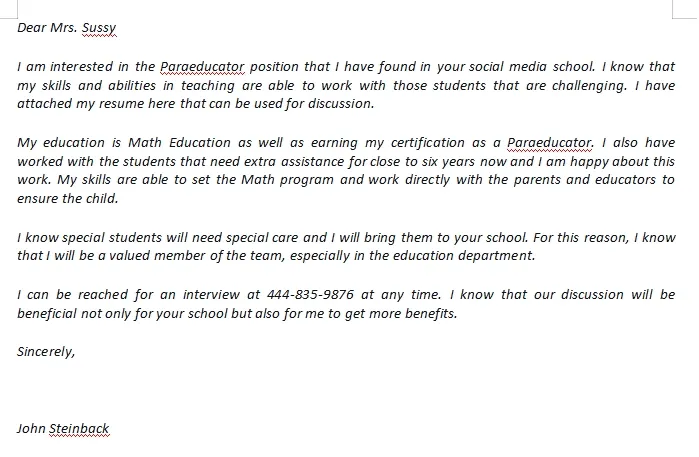
A well-formatted cover letter presents a professional image and makes a positive impression on the reader. Proper formatting enhances readability and shows attention to detail. Use a clear and easy-to-read font. Standard fonts like Times New Roman, Arial, or Calibri are usually a safe bet. Keep the font size between 10 and 12 points. The layout should be clean and organized, with adequate margins on all sides. Avoid excessive use of bolding, italics, or underlining. Instead, use these sparingly to highlight key information. Using bullet points or numbered lists can help to break up text and make your accomplishments and skills easier to read. Proper formatting shows you care about details.
Choosing the Right Font and Layout
Select a professional font that is easy to read. Stick to a common font like Times New Roman, Arial, or Calibri. Ensure consistency in font size and style throughout the document. Keep the font size between 10 and 12 points to enhance readability. Maintain consistent spacing and margins. The margins should be standard at one inch on all sides. Use single or 1.15 line spacing. The layout should be clean and organized. The document should include a professional heading. Include your contact information, the date, and the recipient’s information at the top of the letter. Keep the letter concise, limiting the content to one page. Proper font and layout will help grab the attention of a hiring manager.
Crafting a Compelling Opening
The opening paragraph is your chance to grab the reader’s attention and set the tone for the rest of your letter. Begin by stating the position you are applying for and where you found the job listing. Then, immediately express your enthusiasm for the role and the school or district. Briefly mention one or two of your key skills or experiences that align with the job requirements. Highlight the school’s mission or values, showing that you understand and appreciate their educational approach. The opening paragraph should be concise, engaging, and tailored to the specific role. It should draw the reader in and make them want to learn more about you. Always make sure to tailor your opening to the specific job and the organization you are applying to.
Grabbing the Reader’s Attention
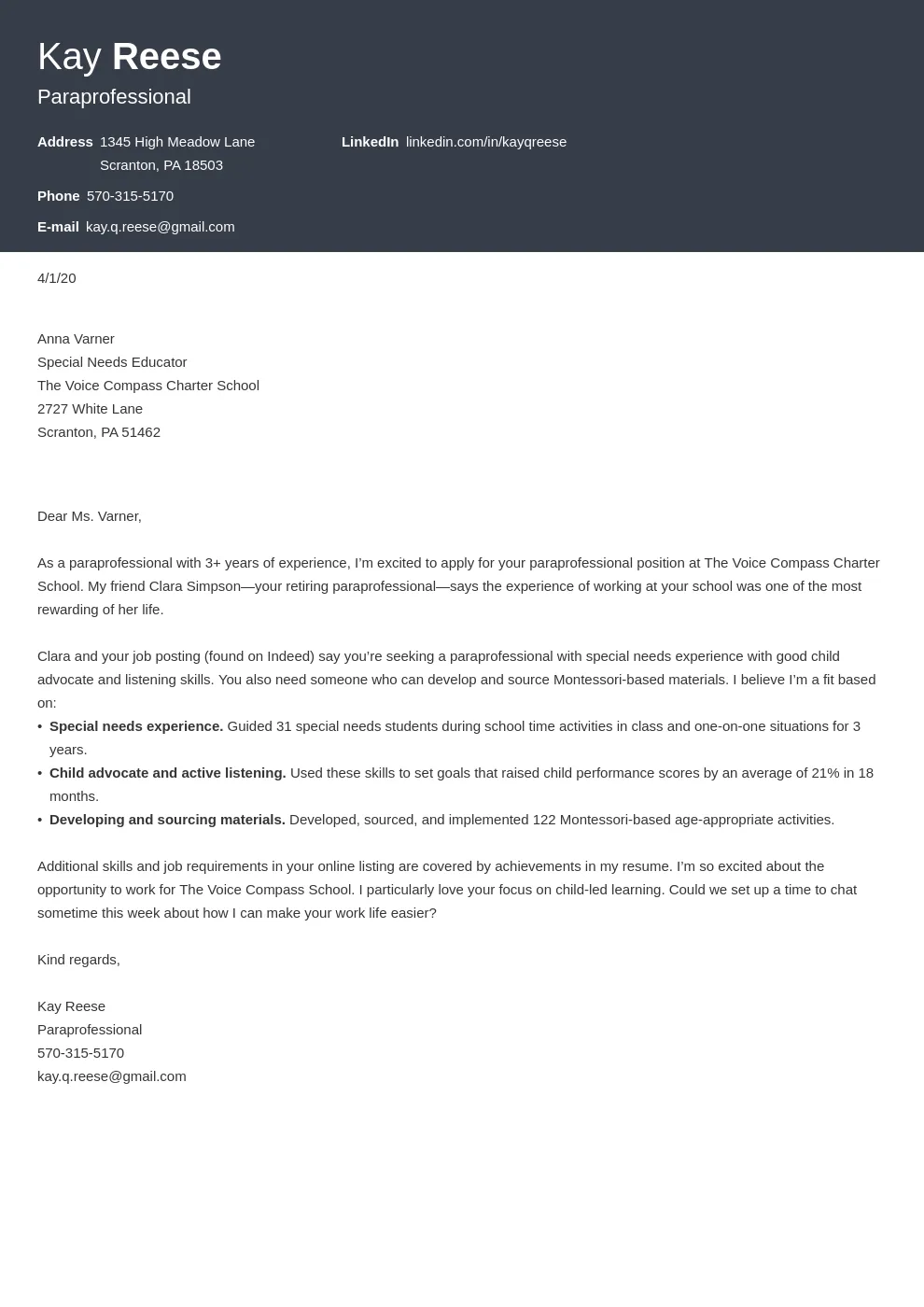
Start with a strong hook. Consider starting with a statement about your passion for education or your experience working with students. Mention something specific from the job description. This will show you have carefully reviewed the posting. You can also share a brief anecdote or personal experience that demonstrates your relevant skills or your commitment to supporting students. Avoid generic opening statements. Instead, provide specific details about your experience. For instance, state your qualifications in a way that is relevant to the role. The goal is to grab the reader’s attention from the beginning and make them want to continue reading.
Describing Your Relevant Skills and Achievements
The body of your cover letter should go into detail about your relevant skills and achievements. Use this section to elaborate on the experiences mentioned in your resume, providing specific examples to illustrate your capabilities. Structure your paragraphs in a clear and organized manner. This allows you to easily communicate your value as a potential paraeducator. Highlight your ability to support student learning, provide classroom assistance, and work collaboratively with teachers and parents. Whenever possible, quantify your achievements by using numbers and data to show the impact of your work. Provide specific examples that showcase your understanding of the responsibilities of a paraeducator role, your dedication to fostering a supportive learning environment, and your passion for helping students succeed.
Using Action Verbs to Showcase Accomplishments
When describing your skills and achievements, use strong action verbs to make your statements more impactful. Action verbs are words that describe what you did. Start each bullet point or sentence with a powerful verb that clearly conveys your role. For example, instead of saying “Responsible for assisting students,” say “Assisted students with…” or “Managed classroom behavior…” “Implemented lesson plans…” “Collaborated with teachers…” “Developed learning materials…” Action verbs bring your achievements to life and create a vivid picture of your contributions. They show employers what you are capable of doing. Choose verbs that are relevant to the paraeducator role and the requirements of the job description.
Quantifying Your Achievements
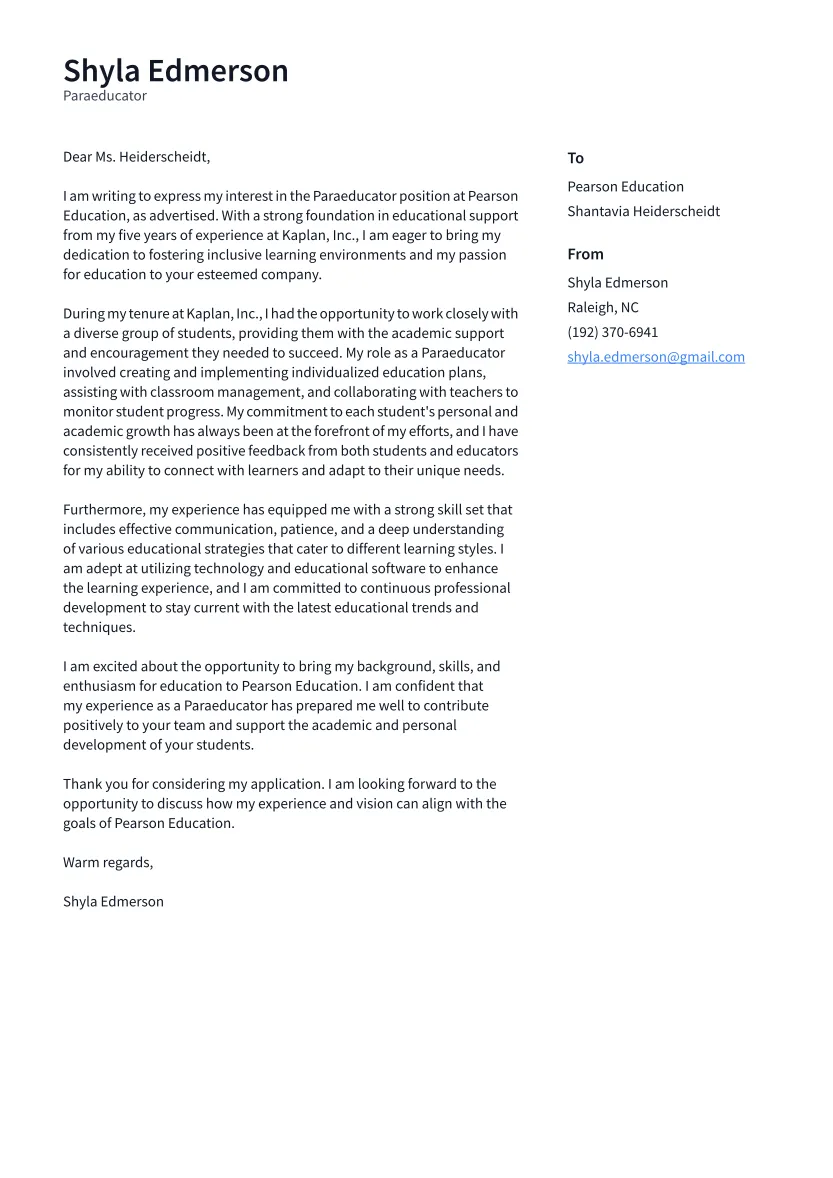
Whenever possible, quantify your achievements to demonstrate the impact of your work. Use numbers, data, and statistics to make your accomplishments more compelling. Instead of saying “Improved student performance,” you can say “Improved student performance by 15% on reading assessments.” Use numbers to support your claims. Describe the number of students you assisted, the number of lessons you helped implement, or the number of parents you communicated with. Providing data makes your achievements more concrete and shows the employer the value you brought to your previous roles. Quantifying your achievements highlights your ability to measure success and your commitment to achieving positive outcomes.
Expressing Enthusiasm and Passion for the Role
Show your passion for the role and for working with students. The tone of your cover letter should reflect your enthusiasm for the position and your genuine interest in supporting student learning. Express your passion for education, and your commitment to helping children thrive. Highlight any personal experiences or values that align with the school’s mission or values. Talk about what inspires you about working in education and what you hope to contribute to the school community. This will help you stand out from other candidates. It also will demonstrate your genuine interest in the role, and it will help you make a personal connection with the hiring manager.
Demonstrating Your Dedication
Show your dedication to providing a supportive and inclusive learning environment. Highlight your ability to adapt to the needs of different students and create a positive classroom atmosphere. Describe your experience working with students from diverse backgrounds, and demonstrate your commitment to promoting equity and inclusion. Discuss your willingness to collaborate with teachers, parents, and other staff members to ensure student success. Mention any training or experience you have that shows your commitment to continuous professional development. By demonstrating your dedication, you assure the employer that you are committed to your role as a paraeducator.
Writing a Strong Closing
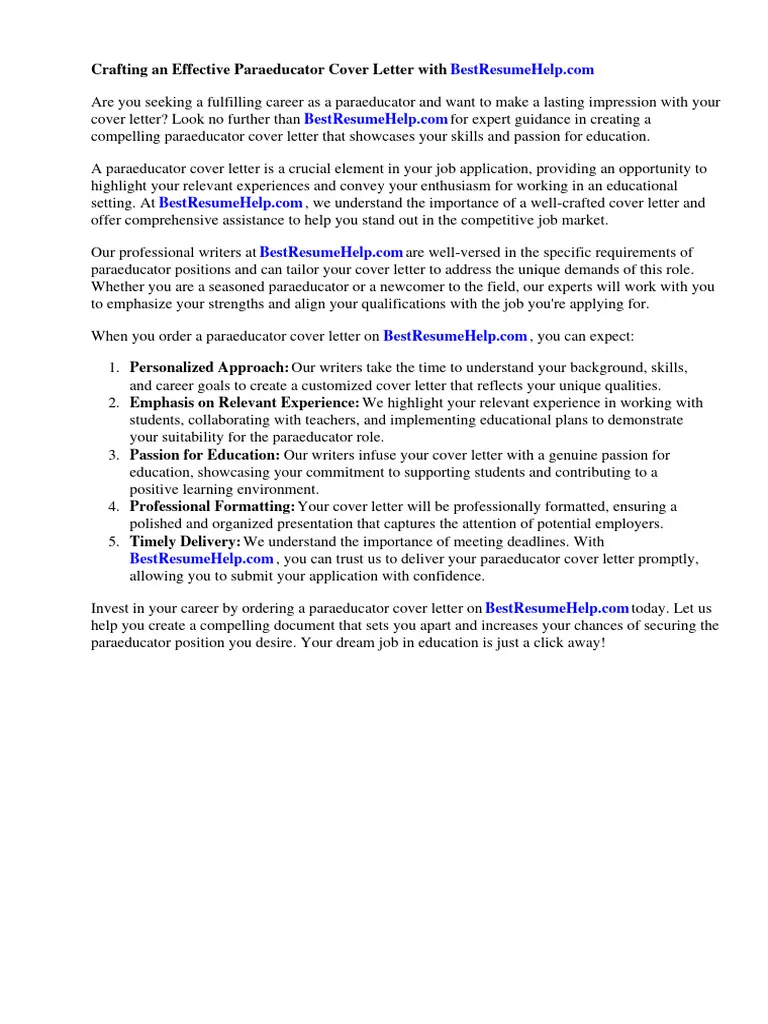
Your closing paragraph should summarize your key qualifications, reiterate your interest in the position, and include a call to action. Briefly restate your most relevant skills and experiences, emphasizing how they align with the job requirements. Reiterate your enthusiasm for the role and express your gratitude for the opportunity to be considered. Include a call to action. Request an interview and provide your contact information. Reiterate your interest in the position. The closing paragraph gives you one last chance to make a lasting impression and to encourage the hiring manager to take the next step. It’s your final opportunity to show your professionalism and commitment to the role.
Including a Call to Action
End your cover letter with a clear call to action. This is a direct statement about what you want the employer to do next. Express your interest in discussing your qualifications further. Make a specific request, such as asking for an interview. Provide your contact information, including your phone number and email address. This makes it easy for the hiring manager to contact you. Thank the reader for their time and consideration. Showing the reader what the next step is will increase the chances that they will take action. Your call to action signals your professionalism and your eagerness to move forward in the hiring process. It shows confidence and a proactive approach.
Proofreading and Editing Your Cover Letter
Before you submit your cover letter, proofread and edit it carefully. Errors in grammar, spelling, or punctuation can make a negative impression. Take the time to review your letter multiple times. Check for any mistakes. Then, ask someone else to read your letter. Another set of eyes can often catch errors that you might have missed. Make sure that your language is clear, concise, and professional. Check for inconsistencies in formatting. Ensure the tone is appropriate for a professional setting. Proper proofreading and editing show the hiring manager that you are detail-oriented. Take the time to ensure your cover letter is polished and error-free. This is critical to making a positive impression.
Checking for Grammar and Spelling Errors
Carefully check your cover letter for any grammatical errors, spelling mistakes, or punctuation issues. These mistakes can make your writing look unprofessional. Use a grammar checker to catch any errors you may have overlooked. Proofread the document multiple times. Read it aloud to catch any awkward phrasing or typos. Ensure your sentences flow smoothly and are easy to understand. Make sure the information is well-structured and easy to follow. Ask someone else to review your letter and provide feedback. Errors in grammar and spelling can give a negative impression. A polished cover letter demonstrates your attention to detail and professionalism.
Seeking Feedback From Others
After you have written and edited your cover letter, ask others to review it. Ask trusted friends, family members, or career counselors to read your letter and provide feedback. Ask them to check for clarity, grammar, spelling, and overall effectiveness. Get their input on the content and the tone of your letter. Ask them if it is easy to understand and highlights your qualifications. Listen carefully to their feedback and be open to making revisions based on their suggestions. Another perspective can often identify areas for improvement. It can also help you to refine your message and improve your chances of making a good impression. Seeking feedback is a critical step in the cover letter writing process.
